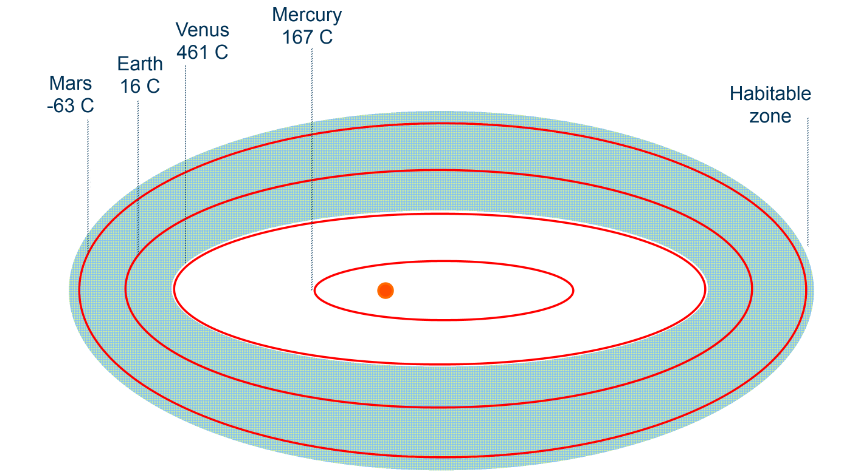
Зазвичай тіла випромінюють радіацію, і зі збільшенням температури збільшується випромінення.
Коли ми дивимось на Сонце чи хоча б відчуваємо його на своїй шкірі, навіть не дивлячись на нього, ми безсумнівно знаємо, що воно щось випромінює. Особливо, якщо забути про сонцезахисний крем.
Із закону зміщення Віна ми можемо дізнатися, що пік випромінення абсолютно чорного тіла залежить від температури. Ані Сонце, ані Земля не є абсолютно чорними тілами, це правило працює і для них також.
Температура Сонця досягає близько 6000K, випромінення на піку сягає ~0.5 μm.
А як щодо Землі?
Давайте спершу дізнаємось, яка у Землі температура.
Коли справа стосується температури планети, є кілька факторів, що впливають на неї. Для Землі це, перш за все, відстань від Сонця, – найголовніший фактор. Наша планета знаходиться у зоні, що є придатною для життя.
Цікаво, що англійською таку зону ще називають Goldilocks zone. Голділокс – це інша реінкарнації казкової Маші, що з предметів у будиночку ведмедів обирала “золоту середину” і ігнорувала екстремальні можливості.
Тож, це означає, що така зона знаходиться не надто далеко, але й не надто близько від Сонця.
Другий фактор – це атмосфера нашої планети. Вона дуже добре затримує тепло.
Середня температура Землі сягає приблизно 16°C. Подивіться на розташування кількох планет сонячної системи та порівняйте умови на них:
Але чому Меркурій холодніший за Венеру, хоча знаходиться значно ближче до Сонця? До речі, цифра, що там вказана, – це приблизна середня величина. Через брак атмосфери на Меркурії соняшна і темна сторони планети дуже відрізняються: 427°C та -173°C, відповідно. Тоді як Венера має товстеньку атмосферну ковдру, яка робить її найгарячішою планетою нашої системи!
Добре, 16°C, десь приблизно 290K, – це просто число, але що воно означає?
Насправді, середнє значення 16°C дуже сильно різниться від локальних температур. Екстремальні температури поверхні нашої планети коливаються від найнижчої зафіксованої -89.2°C на полярній станції Восток (1983) до найвищої зафіксованої 56.7° у місці з романтичною назвою Долина Смерті у Каліфорнії (1913), останню ви ще могли побачити у розв’язці другого сезону серіалу “Справжній детектив”.
Радіація, що її випромінює поверхня, береться з кількох джерел. Перш за все, це короткохвильова електромагнітна радіація, яка досягає поверхні Землі. Близько 45% радіації поглинається покровами Землі, а далі знову випромінюється на довших хвилях. Додатково антропогенні об’єкти, такі як заводи чи геотермальні об’єкти, підвищують поверхневу температуру планети.
По тому атмосфера поглинає, зберігає, знову випромінює цю довгохвильову радіацію. Лише десь приблизно 10% енергії безперешкодно проходить крізь атмосферу.
А як щодо внутнішньої температури Землі? На жаль, вона складає менше за 1% від всього випромінення.
Credit: AIRS Science Team, NASA/JPL
Тут показано температурну карту поверхні землі та хмар у квітні 2003 року. Шкала від -81 (чорний/синій) до 47 градусів (червоний).
Джерело: the azimuth project
Атмосфера поглинає (дивіться на рисунок нижче, де вказані канали поглинання) багато енергії. Ця енергія згодом знов випромінюється як у космос, так і назад на Землю. Цей процес дуже важливий для підігріву атмосфери нашої планети. Близько 70% випромінення від поверхні зберігається таким чином. Далі близько 20% енергії втрачається у процесах випаровування.
Як раніше вже писалося, лише близько 10% радіації, що виходить з поверхні планети, просто проходить через атмосферні вікна. В основнму це вікна, що знаходяться на 8-14 μm. Саме ця радіація важли для дистанційного зондування.
Атмосферны вікна та полоси поглинання – адаптація
Спектри випромінювання використовуються так само, як спектри відбиття, – для характеристики об’єктів поверхні. Певні мінерали мають виразні сігнатури випромінювання, саме їх використовують для визначення мінералів за допомогою зйомки.
Інфрачервоні сенсори також використовуються для знаходження температурних аномалій, таких як, наприклад, пожежі. Температура вогню варьюється між 500K та 1000K і дає пік випромінювання близько 3.8µm, що дуже просто виявити на загальному тлі.
Кольоровий композит для відображення мінералів: залізисті мінерали відображаються у синіх тонах, оксиди заліза у зелених, глинисті у червоних; короткохвильві інфрачервоні канали використовуються у комбінації з видими та ближнімі інфрачервоними, щоби відобразити мінеральну структуру поверхні.









